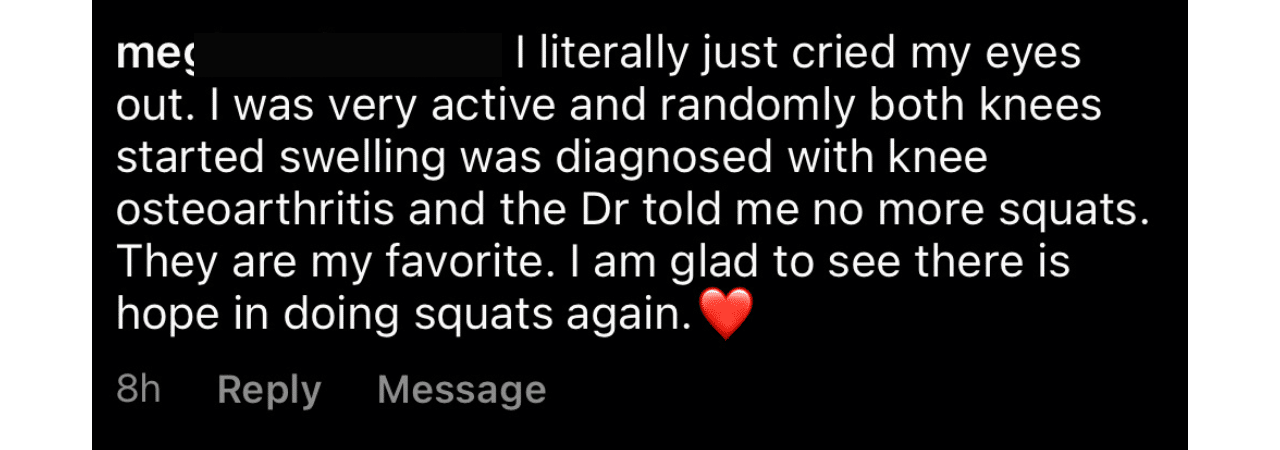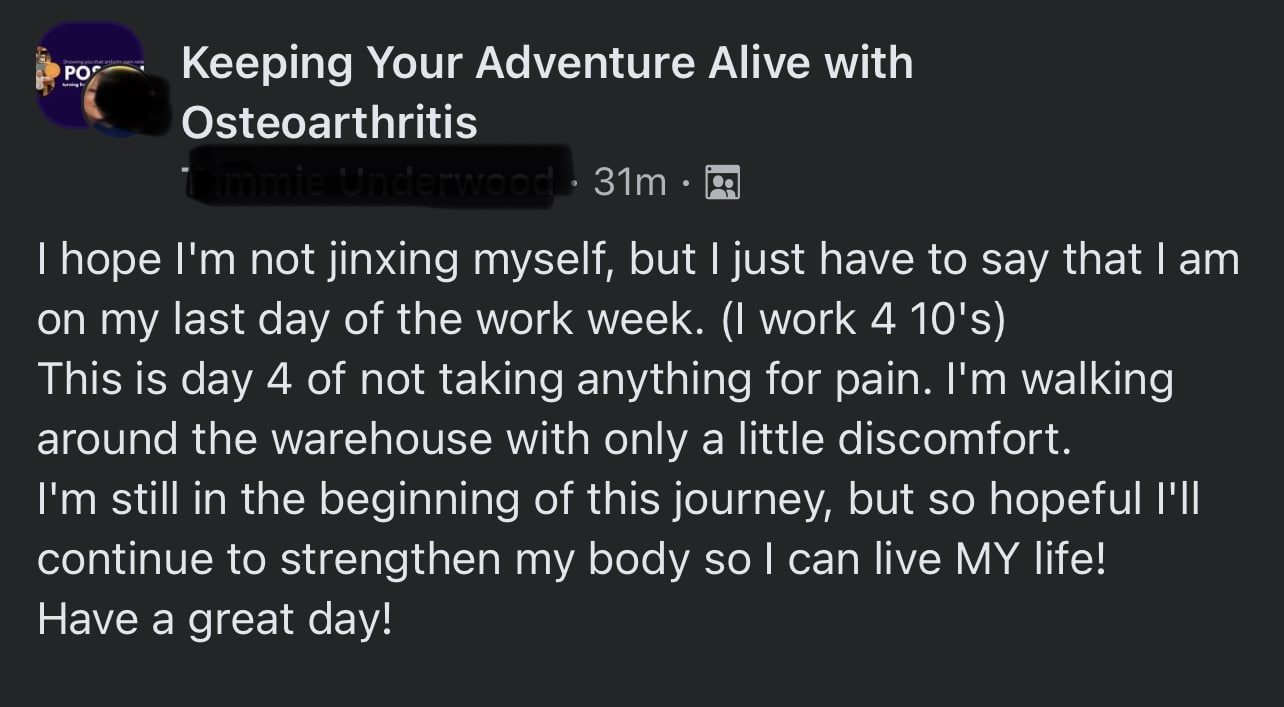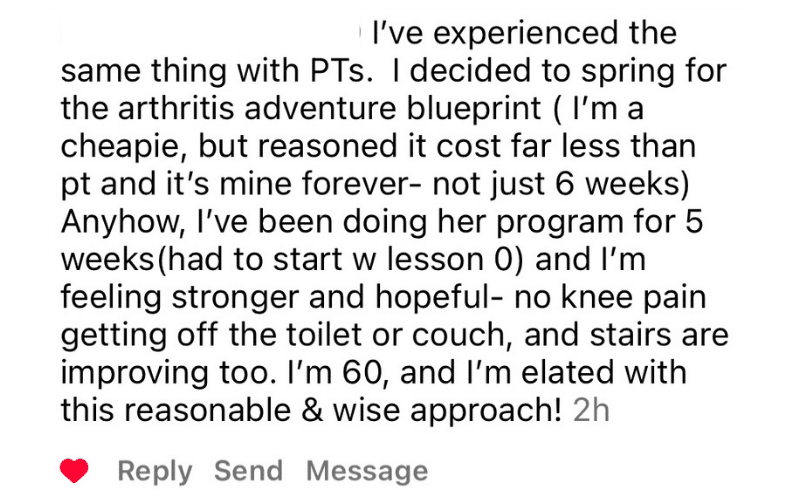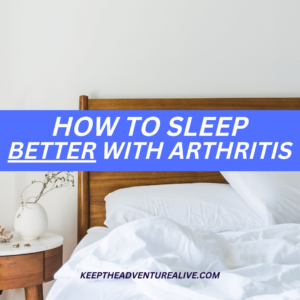If you have knee arthritis pain, it is important to know which things you should and shouldn’t be doing, especially if you are searching for pain relief. As a physical therapist that exclusively works with clients with osteoarthritis- I have found 9 common things that I find myself telling clients to do or avoid. I have included this list below!
This article may contain affiliate links in which Keep the Adventure Alive gets a small compensation if you purchase from the links at no extra cost to you.
Lowdown on knee arthritis pain
If you have knee arthritis pain, movement can seem very overwhelming. It can be difficult to figure out why your knee is angry and how to reduce pain levels. Let me tell you- cortisone shots, and surgical procedures aren’t always the answer.
Depending on the stage of your knee osteoarthritis- there are typically 5 stages– your first step towards relief may vary.
I do want you to know something though: whether you are in the mild stages or if you are bone on bone, there is still hope for relief. Learn more about bone on bone knees here.
Essentially your first step is to figure out what is flaring up your joint pain and figuring out how to reduce these triggers. Problem is, there are a lot of things that can flare up your pain and some aren’t always the most obvious.
Following these simple do’s and don’ts below can help you get started on finding out how to reduce your knee arthritis pain.
1. Do get a second opinion
Just like all other fields, doctors, physicians, and surgeons all have different ways of looking at things. Same goes with physical therapists and other medical professionals.
You may be told many different things when it comes to “fixes” for knee arthritis pain. You would be amazed at what some people are told…
It is so important to find an arthritis specialist that understands you and understands your goals. More on that here.
It is always important to get a second opinion or a new perspective on your arthritis pain. Before deciding on a procedure, injection, or surgery- have someone else take a look at your situation.
This is not saying you shouldn’t trust the medical professional giving you the original opinion. But, someone else may think of something or see something that someone else may have missed. This is especially important before deciding on a joint replacement surgery.
I have met many people who were told:
- not to exercise
- to avoid squats
- that surgery is the only way for relief
- to only do lower impact exercise
- that physical therapy wouldn’t work for them
In these circumstances, this can lead you down a path of depression, inactivity, and hopelessness- a scenario that you are likely trying to avoid!
Keeping an open mind and allowing for a new perspective on your situation can help to open your eyes to all of your options!
2. Don’t overdo it
I know this one may sound easier said than done but hear me out.
One of the main problems I see as a physical therapist primarily treating clients with hip and knee osteoarthritis is the difficulty of managing and preventing flare ups.
Has this ever happened to you? Your knee is finally feeling good so you decide to clean the house, run a few errands, and even walk a few miles with a friend in the evening. Then, when trying to go to sleep that night- your knee is throbbing.
This typically happens when too much activity is done to a point where your joint is sending you signals saying it was too much.
Anytime you experience pain, think of it as your joint is trying to tell you something. Whether it was too much of a certain activity without the right muscle support or stability or sometimes the opposite, not enough activity.
Here is a video on overactivity and how to prevent overdoing it.
3. Do include variety
If you are primarily walking or cycling for exercise to help with your knee arthritis pain, there is something else you can include to maximize your pain reduction and actually make it last…
It is something simple but something that is commonly overlooked and missed.
Thinking about how you typically move throughout the day, what direction are you primarily going? For most of us, it’s going to be forwards. Unless you are playing sports or have heard me talk about this already, you may be missing this one thing…which is VARIETY.

Too often, daily life requires one direction. Walking to the mailbox, walking out to the car, walking into the store, walking to the kitchen- we move forwards A LOT. But what about the muscles that help us move sideways and backwards? They don’t get much love usually.
These muscles are incredibly important though to support your joints, especially in the knee.
If you then are adding walking and/or cycling as your primary form of exercise- that includes more forwards movement.
Simply adding sideways and backwards movement as a warm up or after your walking or cycling routine can be really powerful. It is how many clients I’ve worked with have unlocked things like deep squats, walking longer distances, sleeping through the night, and even running.
Learn more on how you can mix up your routine here.
4. Don’t rest too long
Don’t get me wrong, there is absolutely a time and a place for rest. Your joints do need rest in certain situations.
But resting too much and avoiding movement can actually increase pain. Below is a common fear that many people have with knee arthritis pain and you may have experienced the same thoughts in the past.

The more you rest, does not correlate with “saving your joints” or making the cartilage last longer.
Actually, contrary to popular belief, cartilage responds best when it is under stress during exercise for example. Here’s more on how that works.
The less you use your cartilage, the more that you will typically lose. Along the same lines with muscle and the popular “use it or lose it” saying. Even if you are bone on bone it is important to move.
Without movement you can also experience secondary consequences such as muscle weakness, weight gain, weakening of bones, and chronic disease. With osteoarthritis, it is imperative that movement is at least a part of your day, everyday.
Even if you are bone on bone and are thinking “it’s too difficult to move because everything hurts” I have a workout here that will change your mind 🙂
5. Do Learn to Squat
It is impossible to avoid squats in daily life. This is why it is so important you learn to do so without excruciating pain.
So many people become scared to squat because of the fear that it may cause more damage. Others may have been told to just avoid squats all together from a medical professional or by family members or friends.
Do you relate to her below?

Squatting is ENTIRELY possible whether you deal with low or high levels of knee arthritis pain. Its just about finding the best ways to be able to squat without flaring up your pain or making your knees angry.
But let me tell you something, if you are looking to be able to use the bathroom, get in and out of the car, and sit on the couch- you have to be able to do a squat. There is hope.
Here is a post talking through the 5 reasons of why you are having knee pain with squatting and what to do about it.
6. Don’t accept “take it easy” as a treatment
This is one of the most frustrating pieces of advice lots of people are given when it comes to osteoarthritis and you may have been told this too.
In terms of dealing with pain, “take it easy” is typically not going to lead to relief long term.
If you are in a flare up, sure, temporary rest can be very powerful.
But, one of the most powerful ways to relieve joint pain is to incorporate some degree of movement whether it’s gentle seated exercise or other strengthening movements.
As one of the Arthritis Adventure Blueprint members describes, she was simply told to “take it easy” when her pain flared after working a full week.

The best thing to do to reduce knee arthritis pain and prevent it from recurring is finding what is triggering your pain. This could be the type of activity, muscle weakness, instability, footwear (especially if on concrete, this is my favorite brand), foods you’re eating, etc.
By building muscle strength and reducing inflammation- you can begin unlocking longer term pain relief. Here’s what is possible if you follow the the right path towards relief. This is the same woman from above.

If you’re looking to get started on this path so you can stop wasting time with things that don’t work, I have put everything into the Arthritis Adventure Blueprint to make pain relief possible for you too.
7. Do pay attention to food quality
Food quality can play such a vital role in how your joints feel but is rarely talked about during appointments with medical professionals in traditional healthcare.
This usually isn’t your fault though. Many times professionals may say, “just lose weight” as their attempt to address nutrition. I mean really, those words provide zero help.
Instead, focusing on managing inflammation by looking at the quality of your foods such as what type of ingredients are in the foods and how they impact your blood sugar. Learning more about these things can actually give you specific strategies that will lead to more success with weight loss and inflammation control.
Here is a video below with Dr. Morgan Nolte, a good friend and physical therapist who explains in detail what insulin resistance is and why you need to know about it if you have osteoarthritis.
If you are looking to change the way you eat and start feeding your body foods it actually likes, here is a guide to help you get started.
8. Don’t Give up on your active life
Just because you have osteoarthritis does not mean you cannot lead an active life. It is possible to get your symptoms under control so you are able to do the things you want to.
By taking the right steps you can make all kinds of things possible from walking around the store to finally getting in the car with ease. You can return to hiking and even get back to running.
There are lots of possibilities and I find a lot of the times you are led to believe you can never be active again…
Here is an empowering story about overcoming osteoarthritis.
The most difficult part is knowing what you need to focus on to make these things possible. When you find those missing pieces, you can open the door to so many possibilites.

Just knowing what is possible can be very powerful.
Right now, think of something you would love to be able to do and let that motivate you to start taking action today.
9. Do Take Action
Action is by far the most important thing when it comes to finding knee arthritis pain relief.
There are ways to find short term pain relief with things that are done to you, also known as passive treatments. These typically include massage, chiropractors, pain pills, cortisone shots, PRP, stem cells, knee braces/compression sleeves, supplements, and pain relieving creams.
Passive treatments can have a time and place but it is also important to include active treatments too. These typically include making changes to your diet, the right type of exercise, and regular physical activity.
Relying on passive treatments can make you feel like you are constantly spinning your wheels. You can usually find temporary pain relief but it likely comes back again and again.
If you are looking for the first few steps you need to do to take action to find relief, the Arthritis Adventure Blueprint is calling your name. Hear from one of the current members below.

Learn more about the Blueprint
conclusion
With the right resources, it is possible to navigate knee arthritis pain and actually find ways to prevent the progression of symptoms.
With knee arthritis pain, there are things that can get you closer to pain relief.
Here at Keep the Adventure Alive, my main mission is to help guide you through these steps so you can make adventure possible again- even with knee arthritis!
Disclaimer: This post is for general informational purposes only. It should not be used to self-diagnose and it is not a substitute for a medical exam, cure, treatment, diagnosis, and prescription or recommendation. It does not create a doctor-patient relationship between Dr. Kuhn and you. You should not make any change in your health regimen or diet before first consulting a physician and obtaining a medical exam, diagnosis, and recommendation. Move Well Age Well, LLC and Dr. Alyssa Kuhn, PT, DPT are not liable or responsible for any advice, course of treatment, diagnosis or any conclusions drawn, services or product you obtain through this post, video or site.




